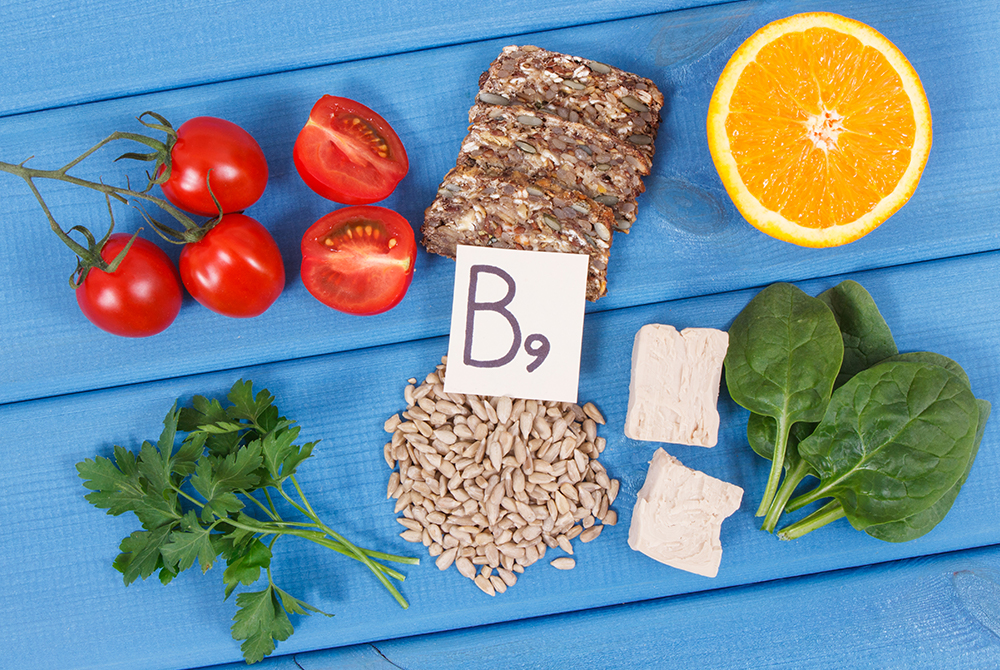Folic acid not only during pregnancy. Effects and sources of folic acid in food.

Folic acid (vitamin B9) is commonly known as a vitamin for pregnant women. Not many people know that folic acid deficiencies can affect almost anyone, and the consequences even manifest themselves through diseases such as atherosclerosis or depression. What is the function of folic acid in the body? What is the risk of its deficiency? What are its sources in food? Finally, is diet sufficient on its own?
Role of folic acid in the body
Folic acid is classified as a water-soluble vitamin. It is vitamin B9. Folates are derivatives of folic acid, which are converted to their active form in the body. These two names are often used synonymously, but it is important to remember that they are not the same compound.
Physiological effects of folic acid include participation in:
- metabolism of nucleic acids,
- synthesis of genetic material - production of purine and pyrimidine bases,
- the methionine cycle - conversion of homocysteine to methionine,
- phospholipid synthesis,
- protein and DNA methylation,
- protein and DNA synthesis,
- blood-forming processes.
The body's requirement for folic acid is the same for adult women and men - it is 400 μg per day. Children need less - 150 μg per day from 1 to 3 years of age, 200 μg until 6 years of age, 300 μg until 9 years of age. Boys up to the age of 18 should consume at least 330 μg of folic acid per day, and for girls as young as 13 the recommended dose is the same as for adult women.
Recommended products with folic acid
Folic acid deficiency
Folic acid deficiencies occur as a result of insufficient intake with food, poor absorption due to intestinal diseases, alcohol abuse, taking certain medications, folic acid methylation disorders and vitamin B12 deficiencies preventing the use of vitamin B9.
Folic acid deficiencies can lead to:
- disorders of the nervous system,
- megaloblastic anaemia,
- atherosclerosis,
- depression,
- dementia,
- pregnancy problems.
Folic acid deficiency is a risk factor for some diseases, but so is an excess. There are some indications that high doses of folic acid may increase the occurrence of certain cancers. This is why it is so important not to over-dose folic acid by consuming dietary supplements. Most often, one dose of a supplement contains 400 μg of folic acid, and such dosage is satisfactory for most people (except pregnant and breastfeeding women). It turns out that folic acid methylation disorders can be very common and affect up to 50% of the population, so it is safer to take methylated folic acid (MTHF), which is already in its biologically active form.
Folic acid in pregnancy
The use of folic acid during pregnancy is obvious nowadays. It is a compulsory supplement for every pregnant woman, and the recommended dosage of folic acid depends on the risk group and is as follows:
- for healthy women – 0.4 - 0.8 mg/day of folic acid in the first trimester of pregnancy, then 0.6 - 0.8 mg/day in the second and third trimester as well as during lactation ;
- for women in the intermediate-risk group, who had pre-eclampsia or intrauterine growth inhibition in a previous pregnancy or have a family history of such cases; who have diabetes, chronic inflammatory bowel disease, coeliac disease, liver or kidney dysfunction, who are obese, have undergone bariatric surgery, use drugs: anti-epileptic, metformin, methotrexate, cholestyramine, sulphasalazine antiepileptic drugs, metformin, methotrexate, cholestyramine, sulfasalazine, also cigarette smokers and heavy drinkers - 0.8 mg/day of folic acid in the form of MTHF (active form of folic acid) during pregnancy and lactation ;
- or women at the high-risk group, who have a previous pregnancy with foetal neural tube defects or who have suffered such defects by mother, father or siblings – 4 mg/day of folic acid in the form of MTHF at least 4 weeks before the planned pregnancy and throughout the first trimester of pregnancy, then 0.6 - 0.8 mg/day in the second and third trimester and during lactation.

Why is the intake of folic acid so essential during pregnancy?
The action of folic acid focuses on its participation in rapid cell division and the synthesis of new copies of genetic material. These processes take place very intensively during pregnancy and the growth of the foetus, so the demand for folic acid increases significantly.
Folic acid deficiency during pregnancy may lead to foetal neural tube defects (NDT), fetus growth abnormalities, heart defects, urinary tract defects, limb defects, cleft lip and palate and Down's syndrome in the fetus. In the case of pregnant women, folic acid deficiency is associated with the risk of thrombosis, megaloblastic anaemia, increased homocysteine levels which increase the chance of atherosclerosis and disturb the blood supply to the placenta, pre-eclampsia and miscarriage.
Folic acid and the risk of anaemia or heart disease
One of the roles of folic acid is to participate in the formation of red blood cells. For this reason, its deficiency can lead to anaemia. The first indicator for too few red blood cells is iron. However, it is good to know that anaemia arises not only in the case of iron deficiency but also due to lack of vitamin B12 and B9, i.e. folic acid. When making a diagnosis of anaemia, it is advisable to test the serum level of folic acid.
Folic acid is involved in the conversion of homocysteine. In case of its deficiency, homocysteine levels in the blood increase, and homocysteine itself is an indicator of the risk of coronary heart disease. Supplementation with folic acid may consequently reduce the risk of coronary heart disease and lower the increased serum homocysteine levels.
Because of its effect, folic acid should not only be taken by every pregnant woman, but by every woman of conception age. Pregnancy is not always planned, and the risks associated with a folic acid deficiency are crucial for the development of pregnancy.
Folic acid sources in food
Folate and folic acid can be found in a variety of different products. The name folic acid comes from the Latin word "folium", meaning "leaf", and suggests that folic acid is found in leafy vegetables. However, they are only the beginning of the list of natural vitamin B9 sources. The usual diet provides an average of 150 to 250 μg of folate. It is not enough to meet the body's requirement for vitamin B9. This is why it is worth increasing the proportion of foods that are good dietary suppliers of folic acid or considering supplementation. Where to look for folic acid in food?

Food products rich in folic acid:
Legume seeds
A glass of cooked beans (177 g) provides 131 μg of folates, and a glass of cooked lentils (200 g) - even 358 μg. Similarly, with chickpeas - 200 g of cooked beans is a source of 344 μg of folic acid. Most cooked pulses provide just over 300 μg of folic acid in a glass (about 200 g).
Vegetables
100 g of cooked asparagus contains 149 μg of folate, beets 109 μg, broccoli 108 μg and artichokes 119 μg. 1 avocado (140 g) is a source of 125 μg. Folic acid in food is also found in brassica vegetables. 80 μg is provided by 100 g of fresh cabbage, and 123 μg are in 100 g of Brussels (6 rounds).
Eggs
One large egg (size L) is a source of 22 μg of folate. Eating 3 eggs a day covers the folic acid requirement (set at 400 μg) by nearly 20%.
Poultry liver
Raw turkey liver contains 677 μg of folic acid in 100 g, and cooked liver contains 691 μg in the same portion. In contrast, there are 588 μg of folate in 100 g of raw chicken liver, 578 μg in cooked and 560 μg in fried. Pork liver is a slightly worse source of folic acid (but still a very good one!), as 100 g raw contains 163 μg of vitamin B9.
Leafy vegetables
A handful of fresh spinach (25 g) is a source of 49 μg of folic acid. Other leafy vegetables have about half as much. A handful of chicory provides 28 μg and rucola 24 μg of folic acid.
Soy products
Products containing folic acid also include soya products, as soya itself is a source of vitamin B9. 100 g of soy flour provides 345 μg of folate and protein supplements provide 340 μg.
Peanuts
There are 240 μg of folic acid in 100 g of unroasted peanuts (approximately three small handfuls or 6-7 tablespoons). Folic acid is found in similar amounts in peanut preparations such as peanut flour and peanut butter. Fried peanuts contain about 120 μg.
Herbs
Products rich in folic acid per 100 g are herbs. Marjoram, basil, coriander or oregano contain around 275 μg of folate per 100 g of dried spices. However, as spices are used in very small quantities, these herbs are not very important in covering the body's requirement for folic acid.
Nuts and seeds
Products rich in folic acid include nuts and seeds from pumpkin, sunflower or sesame. 100 g of nuts and seeds provide approximately 90-100 μg of folate. One handful (30 g) of walnuts contains 30 μg of folic acid, hazelnuts 26 μg, linseed 24 μg and sesame 29 μg. The folic acid content of tahini is the same as that of sesame.
Wheat
Folic acid is found in wheat grains. Wheat germ is especially good source of it. 30 g of wheat germ provides 79 μg of folate. Wheat bread can also be regarded as a product rich in folic acid. Different types of wheat bread contain approximately 100 μg of folic acid per 100 g.

